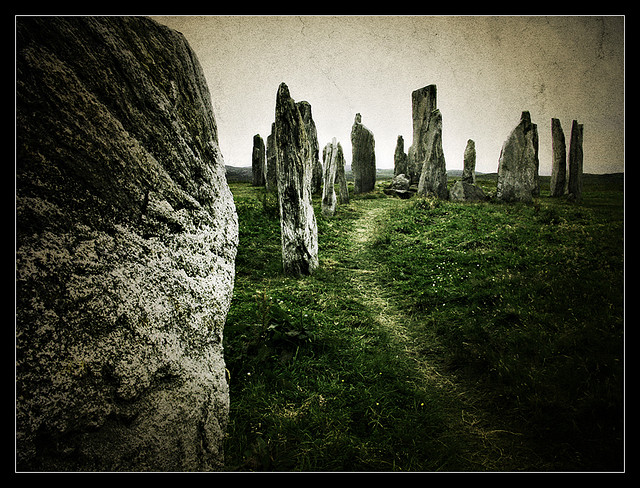 The nature writer Robert Macfarlane is so skilled—so precise, so observant—that he can make an unsuspecting reader long for mudflats. This careful selector of words is also a collector of them: Macfarlane has just published a lovely essay (and a book) about his hoard of “place words,” terms gathered over years of travel in Britain and Ireland. He’s learned that zwer is the sound of partridges taking flight; smeuse is the gap in the base of a hedge made by the regular passage of a small animal; pirr is “a light breath of wind, such as will make a cat’s paw on the water.” A kestrel is a bell-hawk—or, more memorably, a wind-fucker.
The nature writer Robert Macfarlane is so skilled—so precise, so observant—that he can make an unsuspecting reader long for mudflats. This careful selector of words is also a collector of them: Macfarlane has just published a lovely essay (and a book) about his hoard of “place words,” terms gathered over years of travel in Britain and Ireland. He’s learned that zwer is the sound of partridges taking flight; smeuse is the gap in the base of a hedge made by the regular passage of a small animal; pirr is “a light breath of wind, such as will make a cat’s paw on the water.” A kestrel is a bell-hawk—or, more memorably, a wind-fucker.
Most of Macfarlane’s words are old, rescued from obscurity, but he also collects new ones. His young son suggests currentbum for the shiny hump of water that rises over a boulder in a stream; a little girl describes soft grass seeds as honeyfur. “We have forgotten 10,000 words for our landscapes, but we will make 10,000 more,” he writes.
How true, I thought. As the climate changes, so will our vocabulary.
We already have new terms, or newly popular terms, for extreme weather events. We have haboobs in Arizona, and derechos in Washington, D.C. While the Ridiculously Resilient Ridge dried out California, the polar vortex froze the Northeast. We have superstorms and megafires and snowpocalypses, thundersnow and twin tornadoes. (I’m sure Bostonians have a word for those dudes who keep diving out of windows into snowdrifts, but I’m not sure I want to know what it is.)
The people of the Outer Hebrides, Macfarlane writes, have recorded more than a hundred specialized terms for their peatlands, once their primary source of fuel. A feadan is “a small stream running from a moorland loch,” and a fèith is “a fine vein-like watercourse running through peat, often dry in the summer.” Necessity creates particularity: Until your life depends on it, it’s just peat.
For Californians, drought is no longer just drought. It’s a persistent drought, a hot drought, and maybe even a megadrought. Whether or not the state’s historic dry spell is a direct result of the buildup of greenhouse gases in the atmosphere, it’s become vitally important to know how persistent, how hot, or how mega it is. Words that used to be jargon now define the future.
Much of the vocabulary of climate change is too new, too freshly repurposed, or too long denied to have much particularity at all. Climate change itself is vague and distant until it arrives in the backyard. Climate refugees are nameless until you meet one—or become one. Resilience, adaptation, sustainability, and self-sufficiency remain, for the most part, empty words.
Just as each place is defining its own problems, each place needs to define adaptation and resilience for itself. And each will need new place words. Here in Washington State, in the Columbia River Gorge, we already need words for “the color of bare mountain slopes in midwinter” and “daffodils that bloom in February.” East Coasters could probably use more words for “public-transport-crippling storms” and “the smooth mound of snow covering a long-buried car.”
Despite Macfarlane’s lexicographical optimism, he does mourn the abandonment of old place words, and the centuries of careful observation they contain. He decries the Oxford Junior Dictionary’s deletion of words such as acorn, dandelion, and newt in favor of blog, celebrity, and voicemail. He quotes Wendell Berry: “To defend what we love we need a particularizing language.”
To avoid the worst effects of climate change, we need a particularizing language, too. We are, Macfarlane reminds us, the same species that once described a Scottish variety of fast-moving storm-clouds as roarie bummlers, and sometimes uses crizzle as a synonym for freeze. We are still observant, and nothing if not inventive; we are eminently capable of naming both the changes around us and our responses to them. These new words may even have their own particular beauty—terrible though it will sometimes be.
For a fascinating and idiosyncratic dictionary of North American landscape terms old and new, check out Home Ground, written by 45 poets and writers and edited by Barry Lopez and Debra Gwartney.
Top photo: The Callanish Stones in Scotland’s Outer Hebrides. Photo by Flickr user Giorgio Raffaelli. Creative Commons.
You missed a new discriptor for the California drought: geo-engineered.
Dear Michelle,
We would love for you to contribute a word(s) to The Bureau of Linguistical Reality:
http://www.bureauoflinguisticalreality.com/about/
fyi Our March Field Studies Salon will be focusing on discussing themes of drought and fresh water.
Heidi
The Bureau of Linguistical Reality
I’ve always thought the East Coast word for “public-transport-crippling storms” was “Snowmageddon.”